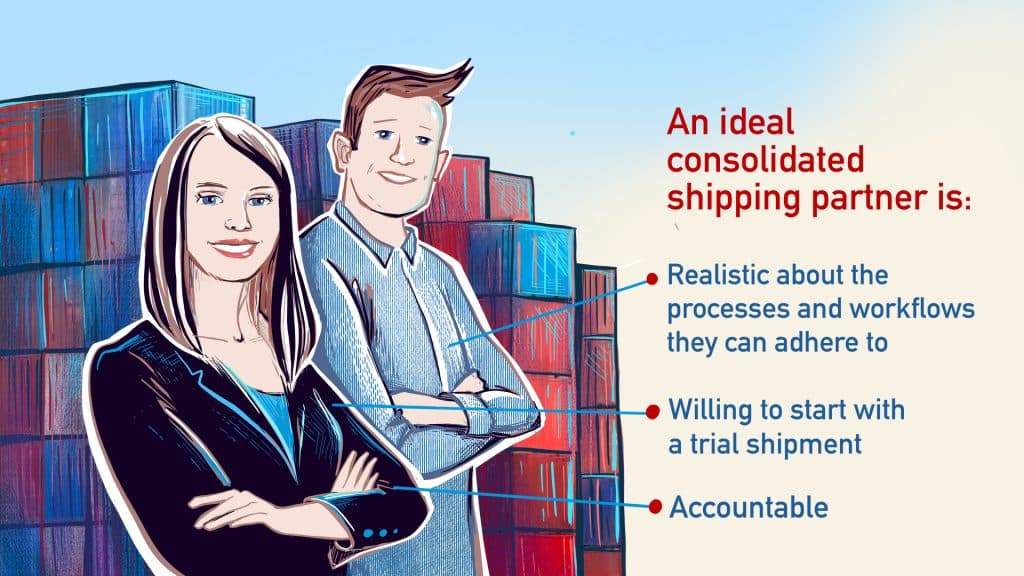
Reducing your shipping and logistics costs can significantly reduce your ecommerce ‘Cost of Goods Sold’ (COGS). While there are many ways to achieve those aims, consolidated shipping is one of the most effective ways to reduce fulfillment expenses.
Anytime you need to ship inventory to a warehouse—either your own or one operated by your third-party logistics (3PL) partner—bulk shipments usually cost less than smaller ones. In particular, shipping inventory at Full Container Load (FCL) prices can offer greater savings per item than shipping inventory at less than Container Load (LCL) volume.
This concept shouldn’t be foreign to ecommerce sellers and customers. Order consolidation is a smaller-scale version of the same principle. When a customer or address is to receive multiple items, either from the same or multiple orders, they can be combined into a single shipment.
Some marketplaces, like Amazon, offer financial incentives to customers who wait for the items to ship together rather than receive the fastest delivery. Amazon also offers consolidated shipments as part of its ‘Fulfilled By Amazon’ (FBA) service.
So, how can you tell if consolidated shipping is right for your ecommerce brand? It starts with weighing the benefits and challenges.
3 Benefits of Consolidated Shipping Over Conventional Fulfillment
The value of consolidated shipping will vary depending on many unique factors associated with your omnichannel ecommerce business. In most cases, sellers who regularly have to move large quantities of inventory and stock between warehouses and 3PL providers stand to gain the most.
Ideally, opting for this style of bulk fulfillment should yield benefits across several areas of your operation, including:
1. Reduced Costs
For the most part, any time you can ship in bulk, you can save dramatically over shipping merchandise piecemeal. Consolidated shipping is about capitalizing on these opportunities to reduce fulfillment costs and your overall COGS. Making it a practice to combine smaller shipments into FCL shipments can give a serious boost to your bottom line over time.
2. Time Savings
While there are additional steps and considerations when opting for consolidated shipping, these steps reduce the time spent preparing and packaging the same merchandise into smaller and individual shipments.
With an effective warehouse management system (WMS) and a properly coordinated team, the palletization and shipping of consolidated orders should result in noticeable time savings in the long run.
3. Overall Efficiency
Larger shipments provide opportunities for shipments to be packed more efficiently.
Palletizing merchandise comes with its own set of optimizations and workflows that can minimize wasted space and eliminate the excess that comes with shipping items piecemeal. This means less wasted packing material, less potential damage during shipment, and a more streamlined freight experience overall.
3 Unique Challenges Associated with Consolidated Shipping
For all its benefits, consolidated shipping does have some potential pain points. If you aren’t careful, the savings from consolidated shipping can be quickly erased due to a lack of planning or miscalculation. These may also be deal-breakers that lead your business to avoid consolidated shipping altogether.
Some of the main challenges of consolidated shipping include:
1. Longer Lead Times
The coordination required to prepare an FCL shipment can be more involved than smaller LCL shipments. Similarly, securing shipping containers and shipment dates can sometimes be more complicated than your traditional fulfillment arrangements.
As such, you will need to plan for longer lead times and rely on accurate predictive data to avoid not having the stock where you need it when you need it.
2. Higher Up-Front Costs
Some ecommerce businesses collaborate with others to take advantage of the large inventory volumes required for consolidated shipping (more on this later). Those who go it alone typically must be able to source the inventory necessary to fill a truck or container.
While this will reduce the per-item fulfillment cost in the long run, achieving those savings requires a higher outlay upfront.
3. Moving Larger Inventory Volumes Can Carry Greater Risks
When putting large quantities of inventory into singular shipments, there is a greater inherent risk that if something were to go wrong, you could suffer significant losses. For this reason, insurance becomes an absolute necessity.
However, even with your inventory value protected, mishaps with such large quantities could lead to greater damages and lost selling potential. Be sure to vet any consolidated shipping provider to help minimize these potential risks, and get insured to ensure you are always prepared for the worst.

Consolidated Shipping Partnerships Open New Opportunities for Savings
Even if the size of your products or overall shipping volume does not meet the threshold to make consolidated shipping a viable option, you may still be in luck. In these circumstances, some brands create partnerships with other similar-sized businesses to take advantage of consolidated shipping.
That said, as with any business arrangement, you need to be sure that you are selecting partners that are a good match for your needs and overall business interests.
An ideal consolidated shipping partner is:
Realistic About the Processes and Workflows They Can Adhere To
Trust is critical whenever you rely on another business to help your business run more efficiently. This is doubly important when your partner’s delays could translate to issues with your ability to get inventory to suppliers and fulfill orders for your customers. Lock in the particulars of any consolidated shipping partnership up front.
Willing to Start With a Trial Shipment
Given the stakes, it only makes sense to test the waters before diving into any fulfillment partnership. Make sure that any potential partner can follow through with their promises.
Accountable
For consolidated shipping partnerships to be worthwhile, all partners must be on the same page. Inaccurate volumes or timings by any of the parties involved can transform a savings opportunity into a costly blunder.
Before entering into any consolidated shipping arrangement, be certain that there is some accountability for all parties involved should something go awry. This could include arrangement terms such as opt-out clauses or financial penalties for failing to comply with shipping dates or volumes.
If you aren’t keen on finding a consolidated shipping partner yourself, know that there are logistics businesses that specialize in making consolidated shipping work. In some cases, you may be able to reach more cost-effective and flexible arrangements with one of these types of logistical partners because most serve multiple clients of different sizes and needs.
This allows more flexibility to create and compile freight shipments than you might have if you handle arrangements independently. No matter how you move your inventory, you need to know where it is and be confident it is handled correctly.
Descartes Sellercloud’s omnichannel ecommerce growth platform combines state-of-the-art inventory tracking and warehouse management tools to give you the insights you need to manage and scale your online retail brand. Furthermore, tools like 4D Scale give you peace of mind that your inventory is measured accurately and precisely—a must to reap the benefits of effective consolidated shipping.
For more on the entire Descartes Sellercloud product suite, contact us directly for a free demo.




